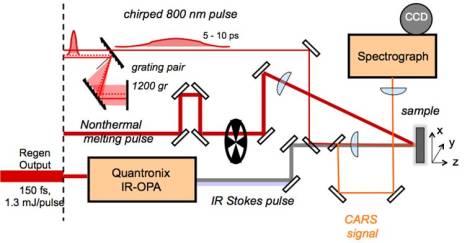Reports: AC6
46633-AC6 The Vibrational Spectrum, Structure, and Bonding of Liquid Carbon
In our proposal to PRF, we proposed to study the structure and properties of the liquid state of carbon by measuring the vibrational spectrum, using our recently developed femtosecond chirped coherent anti-Stokes Raman scattering (c-CARS) technique. The liquid is prepared by nonthermal melting of a graphite target with an ultrafast laser pulse, and vibrational features are to be probed as a function of delay time between the melting pulse (and thus as a function of temperature and pressure) and the c-CARS pulses. The experimental scheme that we have designed and implemented for this experiment is depicted in Figure 1.
Figure 1. Nonthermal melting pulses from a regeneratively-amplified femtosecond laser system are used to melt a graphite target. At subsequent 150-fs delay time resolution steps, c-CARS probes the vibrational features of the liquid state.
Spontaneous Raman scattering is
limited by much lower signals as compared to CARS, the latter process having
significantly faster and easier signal detection as a result of coherence and
directionality. As illustrated in
Figure 2B, the wavelengths involved in the c-CARS process are: (1) Two degenerate and chirped 800-nm
pulses designated as
![]() and
and
![]() , (2) one Stokes pulse
, (2) one Stokes pulse
![]() at 910-nm, which
in this particular example corresponds to the Raman G-band (1600 cm-1)
of carbon, and (3) finally the CARS signal itself. By tuning the Stokes
frequency, it is possible to obtain a multiplexed spectrum of materials over a
spectral window of ~200 cm-1.
at 910-nm, which
in this particular example corresponds to the Raman G-band (1600 cm-1)
of carbon, and (3) finally the CARS signal itself. By tuning the Stokes
frequency, it is possible to obtain a multiplexed spectrum of materials over a
spectral window of ~200 cm-1.
Figure 2. (A) The Raman spectrum of the D band (1350 cm-1) in carbon arises from elastic and inelastic scattering processes. (B) Energy level scheme of the chirped CARS process -- the pump/probe pulses are narrowband while the Stokes pulse is broadband. (C) Spectrum of ethane demonstrating the ability of c-CARS to measure not only solids, but also liquids and gases.
In order to design the details of the c-CARS experiment, it was first necessary to characterize the temporal behavior of laser-induced melting of the graphite target. Time-resolved reflectivity experiments were therefore performed as the first step towards this goal. Upon nonthermal melting of the carbon with the fundamental wavelength 800-nm, a tunable mid-infrared (2000 to 2500 cm-1) pulse probed the transient reflectivity from the target. Figure 3 shows representative traces of the transient IR reflectivity.
Figure 3. Mid-infrared transient reflectivity from nonthermally-melted graphite as a function of delay from the melting pulse. Dynamics decay completely within 3-ps in all cases and show an increase in reflectivity upon melting.
By tuning the Stokes pulse wavelength over 890-nm to 915-nm, the vibrational features of carbon corresponding to 1260-cm-1 to 1510-cm-1 can be probed. However, in this spectral range, no CARS signal has yet been obtained following the nonthermal melting. We suspect that the vibrational frequencies of the liquid state could fall at even lower energies, which could not be explored at this initial stage of the investigation due to technical limitations. Moreover, these vibrational frequencies cannot presently be predicted from theory, indicating the primitive state of knowledge for this exotic substance. The experimental configuration is currently limited by the available range of Stokes pulse frequencies, which originate from second harmonic doubling of the idler photons from the optical parametric amplifier. While CARS is quite optimal for the CH2 stretching regions (previously studied extensively in this laboratory), it is more challenging to shift the probing frequencies to lower energies. To do this must comprise a subsequent phase of this project, which we intend to apply to PRF for support.







